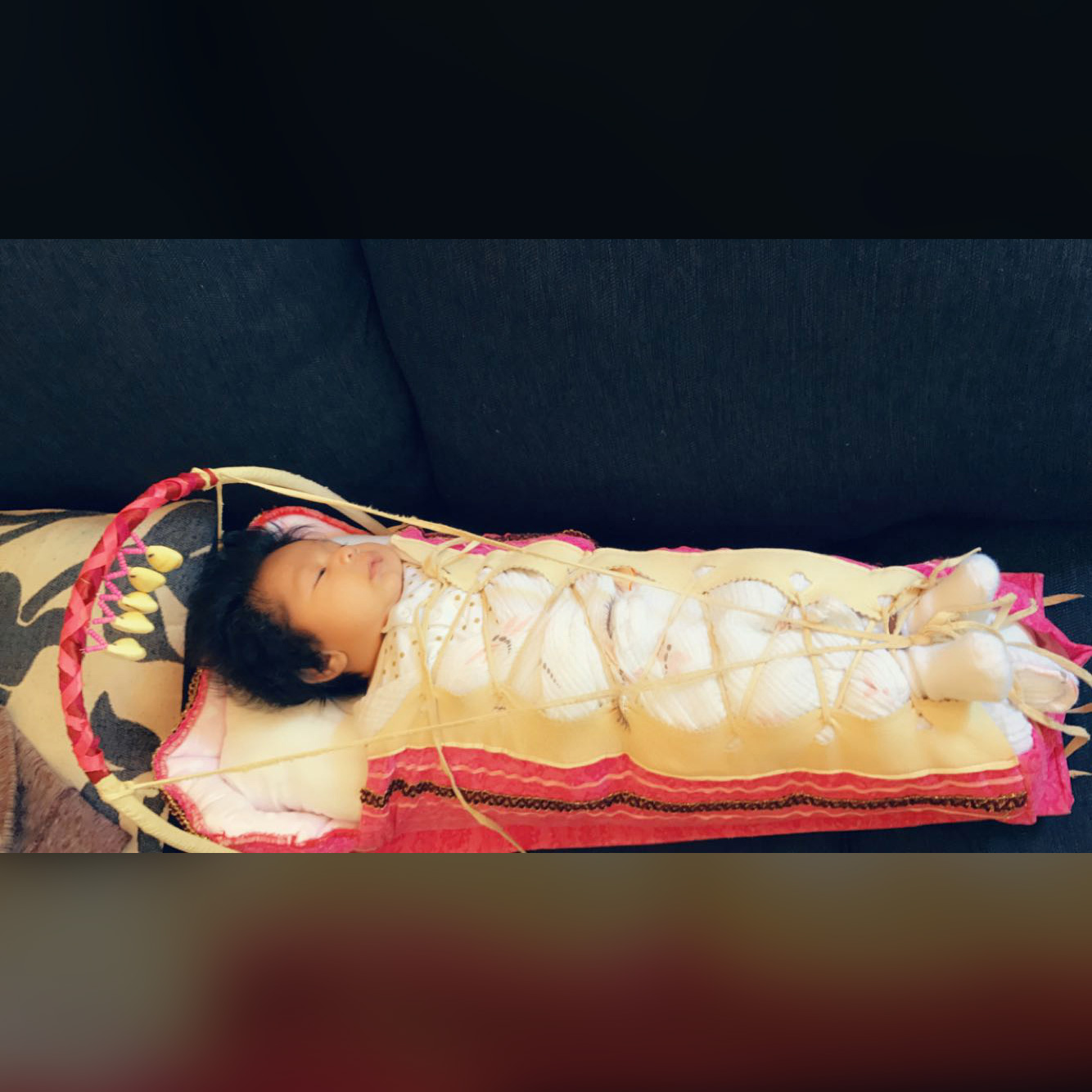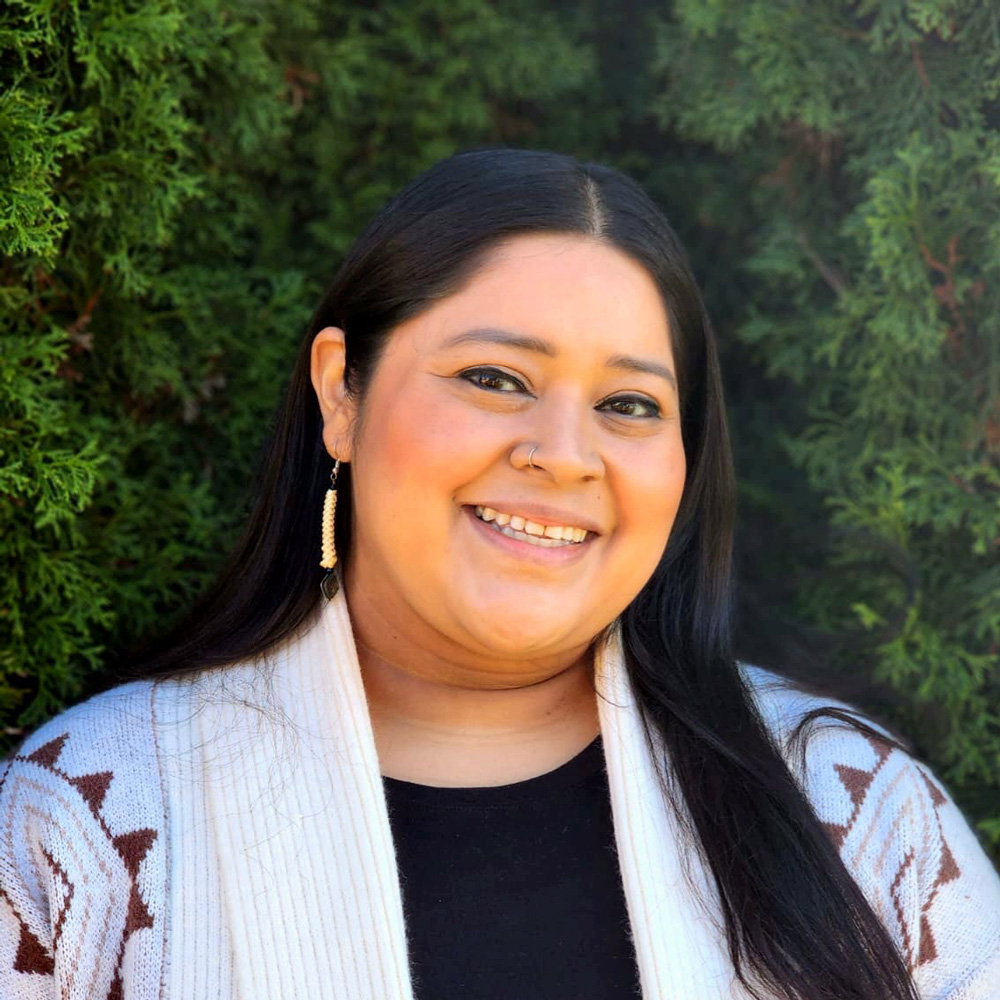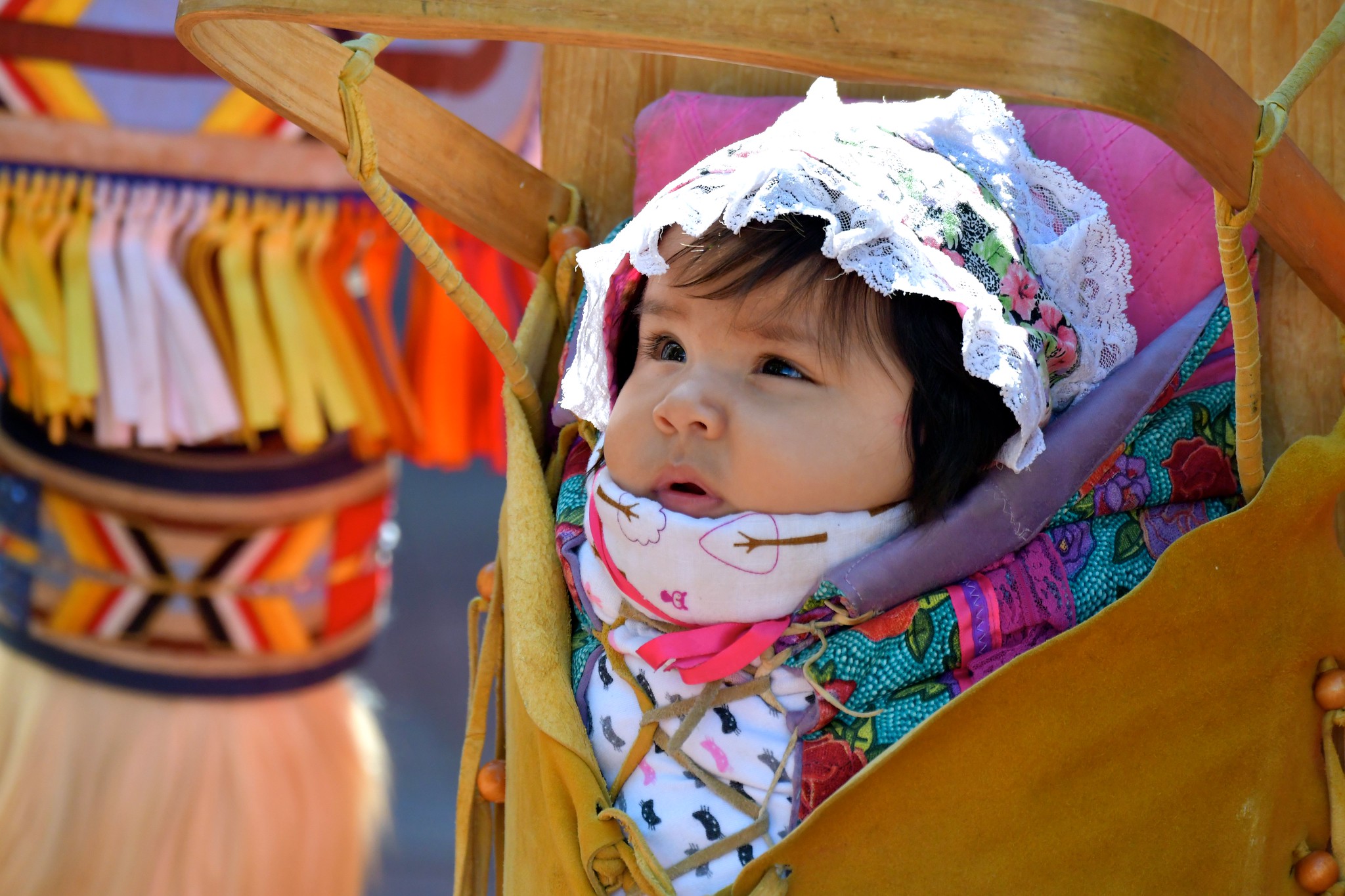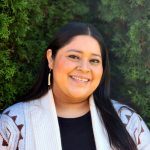Kiowa cradleboard maker Vanessa Paukeigope Jennings, says, “Our cradleboards are living beings” that begin with speaking to the tree that will become the main board. In the Diné tradition, the father finds a pine tree to construct a cradleboard when his wife is pregnant. In the Paiute’s tradition, the child’s umbilical cord is attached to the cradleboard. When the baby outgrows it, the father takes the child to a remote place to bury the cord, telling the child that s/he always has a place in the world. The gifting of the cradleboard honors the child through the immense investment of time, connection to the earth, creative energy visible by elaborate beadwork and embroidery, and prayers. The cradleboard is vital to the child’s development, offering physical safety, spiritual protection, and familial and community connection.

And Grand Ronde Tribal member, Valeria Atanacio, says, “The cradleboard–its construction, movement among family members, and history–is a unique product that brings old and new family members together, rebuilding ties severed by boarding school.
Despite the significance of cradleboards, its use in child care centers had only been permitted through an exemption process that requires a pediatrician’s authorization. The exemption process signals to parents that their care practices are inferior, and demand the oversight of a pediatrician that positions the parents as ignorant, when, in reality, the majority of physicians are unfamiliar with cradleboards.
But there was reason to celebrate on June 21, 2022 when the American Academy of Pediatrics released a policy statement, “Recommendations for Reducing Infant Deaths in the Sleep Environment” making it possible for Indigenous babies to sleep in cradleboards at child care centers without the signed approval of a pediatrician. More specifically, the American Academy of Pediatrics explains that “Some American Indian/ Alaska Native communities have promoted the use of cradleboards as an infant sleep surface,” and that National Institute of Health and Human Development-led Healthy Native Babies Project endorses cradleboards as a culturally appropriate infant sleep surface.”
There is a divide between ECE (Early Childhood Education) and family within a long history of requiring Indigenous children to relinquish their culture in exchange for education. The notion of “standard” has always been rooted in compliance to western knowledge that degrades indigenous ways of knowing. Speaking to Healthy Mothers, Healthy Babies The Montana Coalition, Salisha Old Bull of the Salish and Crow tribes and cradleboard makers, has to repeatedly address the insulting comments and misinformation that cradleboards cause dysplasia of the hip (DDH).
Salish Old Bull Shares her expertise with cradleboards.
Some social workers even consider cradleboarding as child abuse. Helping in Child Protective Services (2004) provides an example of a health inspector citing a child care center by naming cradleboarding as “child abuse” during a visit to an ECE center. Although the Diné parents received an “exception” from the state licensing agency to allow the child to sleep in the cradleboard with help from cultural rights advocates at the state university, the process distressed the parents, disrupted the child’s routine and confused the child care staff.
There is currently no study that shows a correlation between cradleboard and DDH. A 1965 study on the use of cradleboards in a Diné sample found that not all cases with dislocation were cradleboarded, not all cradleboarded infants had DDH, and a few even showed spontaneous improvement of DDH while on the cradleboard. In a study reviewing literature on DDH, medical researchers Jennifer Bracken et al. point out the controversy around its definition. While some studies have shown that DDH is more common in groups where swaddling is prevalent, such as Saudi Arabia, Turkey and Japan, it’s difficult to isolate swaddling as a cause of DDH because swaddling is so common. Approximately 90 percent of infants in North America are swaddled, mimicking being inside the womb, in the first few months of life to help babies sleep.
Bracken et al. present other factors, such as genetic and/or environmental factors, as the potentially primary causes of DDH when they observed the higher frequency of DDH among Black Americans than native Africans. The authors did not name possible environmental factors; however, it is critical that race can be a predictor of pregnancy-related mortality rate and infant mortality rate in the U.S. The medical fields, ECE system and U.S. society at large sweep systemic debilitation of Indigenous communities under the rug by promoting a discourse on the harm of their traditions. Characterizing a benign tradition of cradleboarding as producing ailments in children is a historically rooted strategy that legitimizes the eradication of our cultures and people, positioning the federal government and missionaries as morally superior in their effort to “help” Indigenous people.
The First Nations Health Authority, the National Institute for Children’s Health Quality, and the National Institute of Child Health and Human Development have all identified the cradleboard as “One of the safest alternative sleep surfaces” that can prevent Sudden Infant Death Syndrome (SIDs). The National Institute of Health and Human Development-led Healthy Native Babies Project names cradleboards as a culturally appropriate infant sleep surface. Why have these studies been ignored in the consideration to allow cradleboards in child care settings?
Rejecting cradleboards in child care settings without medical merit continues the dark legacy of boarding schools, which forcibly assimilated Indigenous children from 1819 to 1978. As with many other customs, the use of cradleboards dwindled when Indigenous people were forced onto reservations and boarding schools. The federal government forcibly took Indigenous children from their families, shattering familial bonds, stripping them of their names, cutting their hair, forcing them into uniforms, and banning cultural practices and languages.
As the Department of the Interior continues the long-overdue investigation of the more than 350 Native American boarding schools in the U.S, Indigenous families seek accountability and significant investment. As resilience comes from traditions, to ensure the survival of Indigenous culture requires revitalizing knowledge of cradleboard construction, alongside languages and other traditions. By barring the use of cradleboards at ECE centers, states set up yet another educational hurdle aimed at assimilation and the elimination of ties to Indigenous ways of life.
The ban of cradleboards in ECE settings disrupts healing efforts that aim to reduce intergenerational trauma, SIDS, and major disparities in maternal and infant health outcomes. Indigenous people suffer twice the rate of infant mortality as whites, with Indigenous babies under one-year-old 50 percent more likely to die from complications due to short gestation or low birthweight. It’s a troubling statistic that will likely be undercounted as Indigenous people represent a relatively small population and the data is often disaggregated under “other” where more than one race or ethnicity is marked.
Indigenous organizations across the U.S. are attempting to mitigate these disparities and empower mothers through classes on cradleboards. Recognizing the social determinants of health—including poverty, homelessness and domestic violence—the Native American Women’s Dialog on Infant Mortality in Washington offers cradleboard building and talking circle programs to improve the health of mothers and their babies. The programs connect many urban Indigenous women, who lack direct experience of learning traditions from the community or family due to historical trauma and policies that have disenfranchised Indigenous populations. Also, a Tribal Child Care/Head Start/Early Head Start program in the Rocky Mountains prenatal program teaches each expectant mother to make a cradleboard and the Southwest desert program allows children to use cradleboards on its site.
These updated safe sleep recommendations from the American Academy of Pediatrics integrate Indigenous culture into ECE settings, and creates coherency between the child’s family and learning environments. The endorsement of cradleboards reflects a national effort to protect Indigenous children, as suggested by the Department of Health and Human Services’s renewal of the Healthy Native Babies Project, which provided critical culturally appropriate risk reduction information about Sudden Infant Death Syndrome and other sleep-related causes of infant death to Native communities.
A Grand Ronde Tribal Member Discusses Cradleboards and Family
By Valeria Atanacio

Both of my daughters Amira and Safia used a beautiful pink and white beaded cradleboard, a sleeping and carrying device used by many Indigenous communities across North America, given by my best friend. Much like cribs or bassinets, cradleboards are designed with the infants’ safety in mind. While cradleboards can range in style, they have a rigid frame made of wood or basketry fibers to offer support and to encourage infants to sleep on their backs, and a top hoop or roll bar to safeguard their heads and offer shade. Cradleboards are portable, allowing the infant to socialize throughout the day, as their parents work or run errands.
The cradleboard is much more than a sleeping apparatus; it is a rite of passage for Indigenous parents in my community. It is a journey home after generations of being forced out of our homes and away from our families.
I wanted a cradleboard when my eldest daughter was born, but did not have one in my family nor the knowledge and connection to access one. Because the cradleboard is sacred and serves as protection to babies, the leather, wood and other materials must come directly from the tree and animal, or given by someone who harvested these materials themselves.
When my friend gifted me a cradleboard, she reconnected me to a tradition that had been severed from me. I felt immense love and connection as our children shared cradleboards, intertwining their lives and bonding our two families. Along with the cradleboard, my friend offered prepared meals and stories on motherhood. The gift of the cradleboard carries nourishment and maternal knowledge. Above all, it is a gift of relation and community. I watched my daughters stare at the shells and beads dangling from the top of the cradleboard. They were content.
My inability to access a cradleboard for my children reflects a disconnection from my roots because of systematic cultural erasure through colonialism and boarding schools. I did not have the privilege of sleeping in a cradleboard. There are hundreds of native parents like me: Douglas Limón, an artist in White Bear Lake, Minnesota, wanted–but did not know how– to build a cradleboard for his son. He struggled to find a teacher until he met Judy Pamp at an arts festival in Saginaw, Michigan. Since 2008, Limón has refused to let the tradition die by offering classes on Anishinabe cradleboard construction.
The gifted cradleboard represents a strong intergenerational bond that connects both me and my daughters to those who came before and sacrificed so much for me to be able to hold these traditions and honor the legacy of our people. The cradleboard has been a way to heal in my community and me individually because its ability to soothe babies gives me time to also rest. Many women echo my sentiments on the cradleboard’s utility: “I just don’t think I could ever raise a baby without one, and my daughter felt the same way,” stated Ava Marie Paul, a cradleboard maker who resides in Salt River, Arizona.





